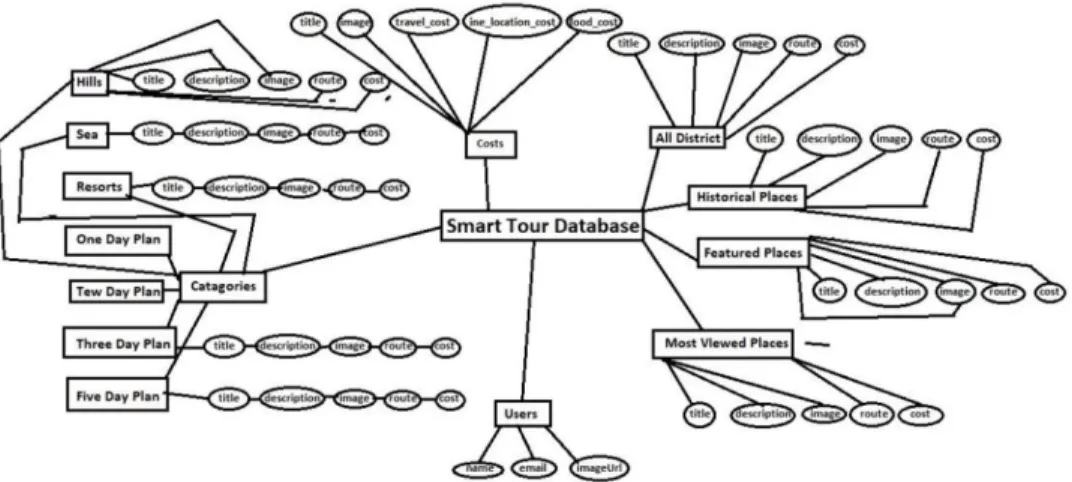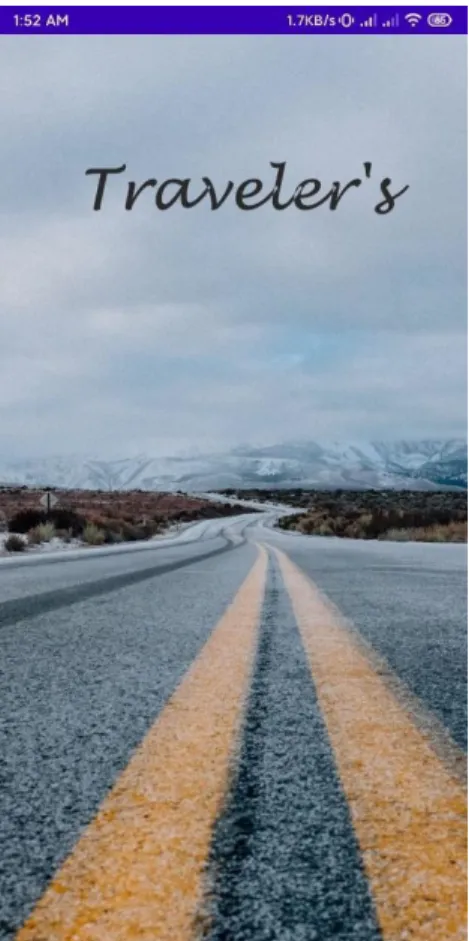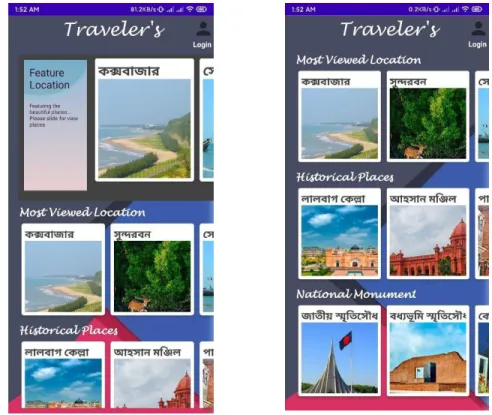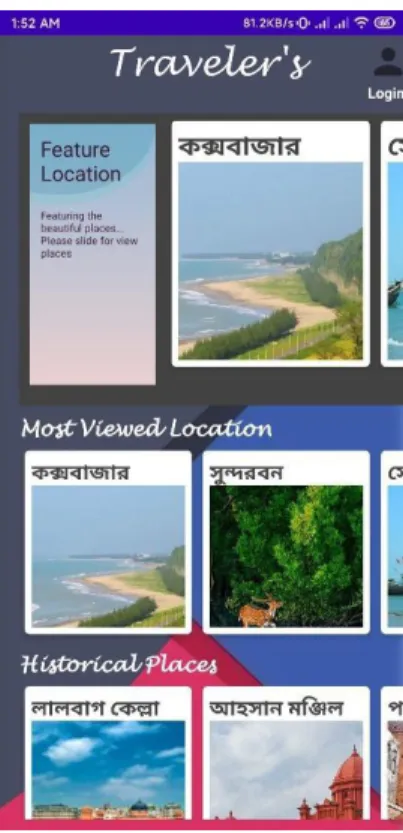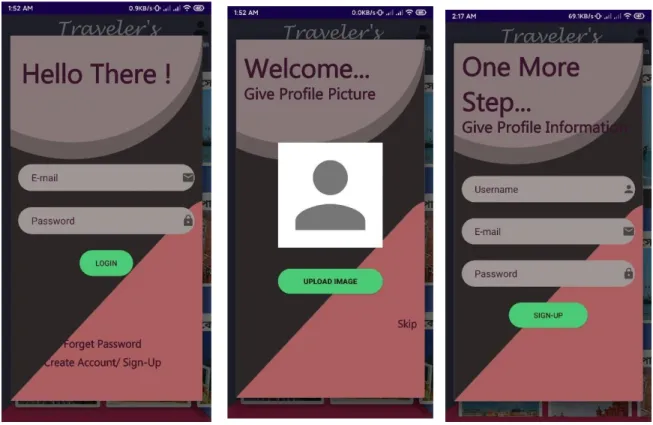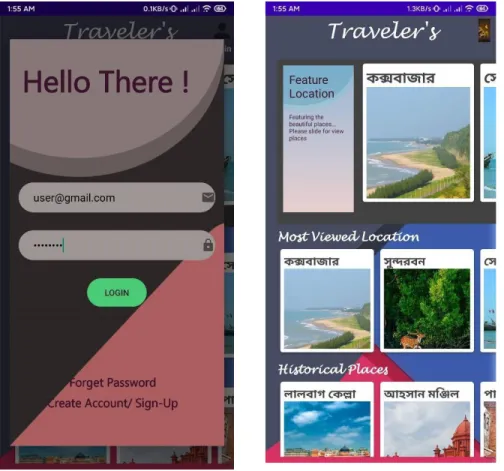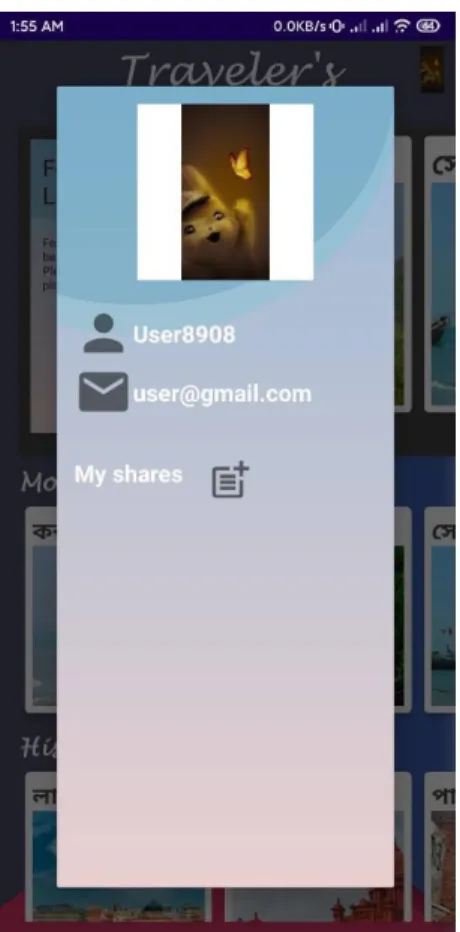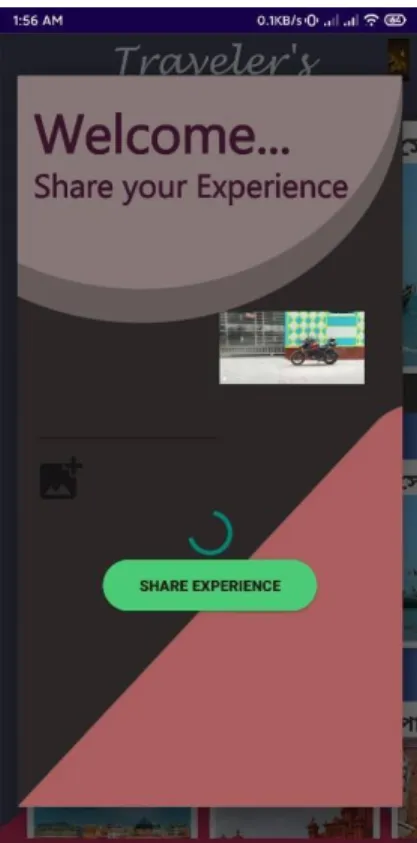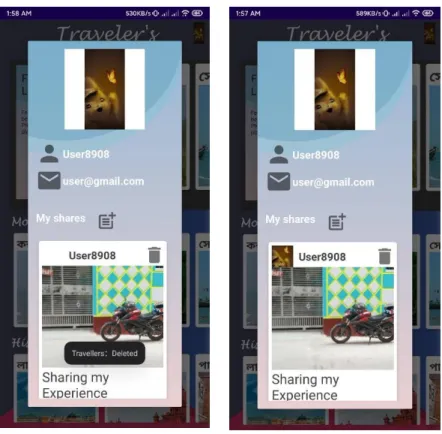1
SMART TOUR APPLICATION BY
Mazharul Islam Shishir ID: 171-15-8908 Sumiya Reza Katha
ID: 171-15-9147 AND
Robin Rahman Rony ID: 171-15-9051
This Report Presented in Partial Fulfillment of the Requirements for the Degree of Bachelor of Science in Computer Science and Engineering
Supervised By
Shah Md. Tanvir Siddique
Assistant Professor Department of CSE
Daffodil International University Co-Supervised By
Md. Jueal Mia
Sr. Lecturer Department of CSE
Daffodil International University
DAFFODIL INTERNATIONAL UNIVERSITY
DHAKA,BANGLADESH JUNE2021
2
©Daffodil International University
APPROVAL
This Project titled “Smart Tour Application”, submitted by “Mazharul Islam Shishir”,
“Sumiya Reza Katha” and “Robin Rahman Rony” to the Department of Computer Science and Engineering, Daffodil International University, has been accepted as satisfactory for the partial fulfillment of the requirements for the degree of B.Sc. in Computer Science and Engineering and approved as to its style and contents. The presentation has been held on
“June 03, 2021”.
BOARD OF EXAMINERS
________________________
Dr. Touhid Bhuiyan Professor and Head
Department of Computer Science and Engineering Faculty of Science & Information Technology Daffodil International University
Chairman
3
©Daffodil International University ________________________
Most. Hasna Hena Assistant Professor
Department of Computer Science and Engineering Faculty of Science & Information Technology Daffodil International University
Internal Examiner
________________________
Sumit Kumar Banshal Senior Lecturer
Department of Computer Science and Engineering Faculty of Science & Information Technology Daffodil International University
Internal Examiner
________________________
Shah Md. Imran
Industry Promotion Expert
LICT Project, ICT Division, Bangladesh
External Examiner
4
©Daffodil International University
DECLARATION
We hereby declare that, this project has been done by us under the supervision of Name, Designation, Department of CSE Daffodil International University. We also declare that neither this project nor any part of this project has been submitted elsewhere for award of any degree or diploma.
Supervised by:
Shah Md. Tanvir Siddiquee Assistant Professor
Department of CSE
Daffodil International University
Co-Supervised by:
Md. Jueal Mia Sr. Lecturer
Department of CSE
Daffodil International University
5
©Daffodil International University Submitted by:
(Mazharul Islam Shishir) ID: 171-15-8908
Department of CSE
Daffodil International University
(Sumiya Reza Katha) ID: 171-15-9147 Department of CSE
Daffodil International University
(Robin Rahman Rony) ID: 171-15-9051
Department of CSE
Daffodil International University
6
©Daffodil International University
ACKNOWLEDGEMENT
First we express our heartiest thanks and gratefulness to almighty God for His divine blessing makes us possible to complete the final year project/internship successfully.
We really grateful and wish our profound our indebtedness to Shah Md. Tanvir Siddiquee, Assistant Professor, Department of CSE Daffodil International University, Dhaka. Deep Knowledge & keen interest of our supervisor in the field of “Android Application Development” to carry out this project. His endless patience, scholarly guidance, continual encouragement, constant and energetic supervision, constructive criticism, valuable advice, reading many inferior draft and correcting them at all stage have made it possible to complete this project.
We would like to express our heartiest gratitude to Shah Md. Tanvir Siddiquee, Prof.
Dr. Touhid Bhuiyan, and Head, Department of CSE, for his kind help to finish our project and also to other faculty member and the staff of CSE department of Daffodil International University.
We would like to thank our entire course mate in Daffodil International University, who took part in this discuss while completing the course work.
Finally, we must acknowledge with due respect the constant support and patients of our parents.
7
©Daffodil International University
ABSTRACT
This project titled “Smart Tour App”. We are trying to develop an android application that will help all the people and people who love travelling in our country. And we hope that this application also will helpful for foreign traveler those are come for travel our country.
Users can see all the important travelling places through the app and get their desire information. We tried to give all the important information through the application. All kind of people with smart phone can access this application and get their desire information. Also they can sign-up and login. But it’s a choice for people. They can easily login with their email. We are also trying to build this application more dynamic day by day. In future we will give more features in this application. We will work more with this application.
8
©Daffodil International University
TABLE OF CONTENTS
CONTENTS PAGE
Board of examiners ii-iii
Declaration iv-v
Acknowledgements vi
Abstract
Table of Content List of Figure
vii
viii-ix
x
CHAPTER 1: INTRODUCTION
1-21.1 Introduction 1
1.2 Motivation 1.3 Objectives
1.4 Expected Outcomes
CHAPTER 2: BACKGROUND
2.1 Introduction 2.2 Related Works 2.3 Comparative Studies 2.4 Challenging
CHAPTER 3: REQUIRMENT SPECIFICATION
1-2
2
2
3-4 3 3 3 4
4-6
9
©Daffodil International University
3.1 User Case Modelling and Description 3.1.1 Functional Requirements
3.1.2 Nonfunctional Requirements 3.2 User Case Modeling and Description
3.3 Logical Data Model 3.4 Design Requirements
CHAPTER 4: DESIGN SPECIFICATIONS
4.1 Front-end Design 4.2 Back-end Design
4.3 Interaction Design and UX 4.4 Implementations Requirements
CHAPTER 5: IMPLEMENTATIONS AND TESTING
5.1 Implementations of Database
5.2 Implementations of Front-End Design 5.3 Testing Implementations
5.4 Test Results and Reports
CHAPTER 6: CONCLUTION AND FUTURE SCOPE
6.1 Discussion and Conclusion 6.2 Scope for Further Development
4 4 4
5 5 6
6-22
6-19 20-21 22
22
23-25
23
23
24
25
25-26
25
26
REFERENCES
2610
©Daffodil International University
LIST OF FIGURES
FIGURES PAGE NO
Figure 3.1: User Case Diagram 5
Figure 3.2: Entity-Relationship Model 5
Figure 4.1: App Starting Screen 7
Figure 4.2: Home Screen and Home Screen Scrolling 8
Figure 4.3: Login or Signup dialog 9
Figure 4.4: After Login 10
Figure 4.5 User Profile 11
Figure 4.6: Sharing Experience 12
Figure 4.7: View experience on profile and remove it 13
Figure 4.8: App Navigation Drawer 14
Figure 4.9: All Division and District Menu 15
Figure 4.10: District and District Details 16
Figure 4.11: Travelling sites categories 17
Figure 4.12: Cost information View 18
Figure 4.13: See shared experiences 19
Figure 4.14: All user authentication 20
Figure 4.15: All user and information database 21
Figure 4.16: All user and information picture storage 21
LIST OF TABLES
2
©Daffodil International University
TABLES PAGE NO
Table 01: A Test Case for The System 24
1
CHAPTER 1 Introduction
1.1 Introduction
Now a day smartphone is essential for all kind of people. Which gives advanced technologies and features. That feature which gives a similar functionality of a computer.
So, now people try to do all their tasks and daily necessary tasks through smartphone. It’s a part and parcel of daily life. The thing that make more necessary of smartphone is its app which we get from various website or play store. We noticed that now a day people are so habituate for traveling and exploring outside. But there are no good amount of applications which give more information that can fulfill their desires.
There are bunch of application that are used for travelling. In this case the user will use the app name a “TRAVELER’S”. This is an android base application. The application designed for all android smartphones and tablet mobiles. People can easily download this application from google play store. After installing they can sign-up and login their account and get their desire information. People can also get their information without login or sign-up. So it’s open for all. The app is more useful for those who travel in our country and also those who come and travel our country.
2
©Daffodil International University
1.2 Motivation
Technology growing day by day in our country. We can get our daily necessary stuffs through online. All the service happening through smartphones mostly because of people can move it anywhere anytime. It’s hard for people to travel unknown place without knowing basic information about that place. Sometime people got lost while travelling in now places.
Our motive is make an application which can be usable in smartphone to ensure a decent amount of information for pre travelling in any place.
Some applications are similar like our application but they develop partially. They have so many bugs and derived to websites for information. This app ensure a better and safe travelling for all that who travels and love to travel.
1.3 Objectives
1. Develop an android base travel guide system.
2. Make friendly platform for all.
3. Cloud-based data management.
4. An efficient system for all kind of people.
5. Efficient information gathering system.
1.4 Expected Outcome
1. All expected locations details.
2. Information of travelling routes.
3. Experience Sharing.
4. Travelling Categories.
5. Countries all district information.
3
©Daffodil International University
CHAPTER 2 Background 2.1 Introduction
This is an application deals with travelling information with is useful for all kind of people and travelers. This is more efficient and easier for people for finding places and places information. Everyone want to save their valuable time and want easier solutions. All they wants more user friendly and efficient platform. There are similar applications on web sites and app store. But there are so small count of applications which for our country travelling and some of them are poor maintenance service. They gives only simple information that doesn’t full-fill users demands. All the things that we are thinking about our unique and user friendly application from others.
2.2 Related Works
● Travel Bangladesh
● Vromon Guide.
● Tour Today BD.
● Bangladesh Travel Guide.
2.3 Comparative Studies
Comparatively, there are application available in the market. Moreover, the applications are not full active. Most of them the main platform are web-based application. On the other hand they have bugs. Some of our friends are trying to make this type of application but they have different thoughts. And they are partially making this app.
2.4 Challenges
4
©Daffodil International University
Requirement: The most challenging matter is fulfill the design of application so that user willingly use the application. Sometime we fall in bugs when the version will updates while developing updates. Sometime there is some invisible error that is very much tough to find and correct them. It needs spends some hours.
Poor Communication: We are three members developing this project. Moreover we have to work in pandemic of COVID-19. So we spend months in lockdown. It’s very tough to get together and solve every steps of the project.
CHAPTER 3
Requirement Specification
3.1 Requirement Collection and Analysis
The primary condition of development are required analysis and requirement collection.
Two type of requirement for development are functional requirement and nonfunctional requirement. Those activities are performed by software and that’s called functional.
Nonfunctional requirements generally defines the personality of an application.
3.1.1 Functional Requirement: In our project, there are authentic login, signup, database system which are consider as functional requirements.
3.1.2 Nonfunctional Requirement: Nonfunctional requirements are usually depends on how much user friendly UI are using. UI should be user-friendly and gorgeous for user experience. XML design in android is considerable as nonfunctional requirements.
3.2 User Case Modeling and Description
5
©Daffodil International University
Login
User
Admin Database Profile
Travel Information
Figure 3.1: User Case Diagram
User can sign-up and login in this application and search and get his required information.
Admin can insert and update data for database from backend.
3.3 Logical Data Model
An entry-relationship diagram (ER- diagram) shows the relation of entry which stored in database. An entry in the context is an object and a component of data. These entities can have attributes that define its properties.
The logical data model presents the entity-relationship diagram called the ER-diagram.
Figure 3.2: Entity-Relationship Model
6
©Daffodil International University
3.4 Design Requirement
Every application or system must be considered that reproduced the overall design of goals that the system expected to achieve. The project design will differ the system with other application system. Some points for the design requirement are given below.
Efficient: Run the application faster on any device is very important. We made our application very smooth and bug free.
User-Friendly: The application is very user friendly. People can easily able to access all feature smoothly. The design is very smooth and all layouts are very well decorated.
Compatible to Various Device: Our application compatible with any android smartphones that support the minimum SDK level 23.
CHAPTER 4 Design Specification
4.1 Front-End Design
Front-end is the visual part of an application. It contains two parts and those are XML file for design user interface and JAVA class for developing logical operation for that user interface.
In our application we use various type of activity layouts and various type of labels such as recycler view, card view, edit text, text view, image view, button, scroll view, dialog.
We also use some extra XML file and classes to make our application much user friendly.
So that it become easy to use for user. As a result, the interface turned simple and attractive.
7
©Daffodil International University
Figure 4.1: App Starting Screen
Figure 4.1: Starts the applications and shows loading screen with application name
8
©Daffodil International University
Figure 4.2: Home Screen and Home Screen Scrolling
Figure 4.2: After loading screen home screen will appear and users can scroll the home page and see contents.
9
©Daffodil International University
Figure 4.3: Login or Signup dialog
Figure 4.3: When user tap on login a login dialog will appear. If user is not registered for login he can sign-up and login.
10
©Daffodil International University
Figure 4.4: After Login
Figure 4.4: After login user profile picture stand in top right corner of home page
11
©Daffodil International University
Figure 4.5: User Profile
Figure 4.5 User can see his/her profile by tapping profile picture in home page
12
©Daffodil International University
Figure 4.6: Sharing Experience
Figure 4.6: User can share his/her travelling experience. So that that share will helps others.
13
©Daffodil International University
Figure 4.7: View experience on profile and remove it
Figure 4.7: User can see his share in his/her profile and also can delete it if user wants
14
©Daffodil International University
Figure 4.8: App Navigation Drawer
Figure 4.8: User gets couple of app options from left side slide navigation drawer
15
©Daffodil International University
Figure 4.9: All Division and District Menu
Figure 4.9: User gets all division in all division menu and user can search division
16
©Daffodil International University
Figure 4.10: District and District Details
Figure 4.10: Tapping the division we get districts of selected division and get more details of district.
17
©Daffodil International University
Figure 4.11: Travelling sites categories
Figure 4.11: In categories option we found some useful travelling categories, and find expected places and details.
18
©Daffodil International University
Figure 4.12: Cost information View
Figure 4.12: In cost information menu user can see a places minimum costs of basic travelling costs and calculate it based on persons and days
19
©Daffodil International University
Figure 4.13: See shared experiences
Figure 4.13: Lastly user can see others shared experiences for better and real time information.
20
©Daffodil International University
4.2 Back-End Operations
As developing an android application we must consider some important back-end operations. Database is the major of our application. All task performed based on database. We use “Firebase Database” as storing data. Firebase database fast and have real-time database. Some back-end operation are given below:
● Search by key.
● Automatic real-time data synchronization.
● Automatic server maintenance.
● Firebase Data storage and file storage.
● Easy user authentication.
Figure 4.14: All user authentication
21
©Daffodil International University
Figure 4.15: All user and information database
Figure 4.16: All user and information picture storage
22
©Daffodil International University
4.3 Interaction Design
Everyone wants an interaction design for their smartphones and tabs. Interaction design can make the app more user-friendly and attractive to users. It can create products that enable the user to achieve their objective in the best way possible. It is the only way to observe between a system and its user.
4.4 Implementation Requirements
For implementing the project we needed Android Studio for design and development of the whole project. For back-end we need web browser and google account. For testing we need JDK and SDK. A virtual device AVD is also needed for testing the application. Also a storage internet connection needed for update the Gradel file of the Android Studio.
23
©Daffodil International University
CHAPTER 5
Implementation and Testing 5.1 Implementation of Database
Task of creating a database to load the data. In firebase it’s so easy and simple to create a database. We connected our app to database through our app, we made all the data collections. This is the implementation process of our database. The three major process are given below:
● Firebase Authentication.
● Firebase Real-Time Database.
● Firebase Storage
We used Query to store and retrieve data from the database. We use firebase storage section for store image files and generated an image link to the database using some queries so that we can access it so easily. Besides we stored all the data in real-time database. We used Firebase Authentication to make a unique id for separation of all users.
We related all of the facilities of the firebase database to our application by java classes, various libraries and dependencies. For executing our application with connection of database we used many methods to upload data, retrieve data and register through Firebase Authentication.
5.2 Implementation of Front-End Design
In android studio front-end design in related to XML file and java classes. XML files are used to design user interface (UI). In XML file we added various type of layouts, recycler viewer, card view, navigation drawer. Then we relate all the things with class by calling them in logical operation of classes.
24
©Daffodil International University
5.3 Testing Implementation
The application is tested basically for correctness of application. Besides, testing is an integral part of application. The software interfaced with other software/hardware system.
System Testing is a series output. There are some of test case of our app are given below:
Table 01: Test Case for the System
Test Case Test Input Expected Outcome
Obtained Outcome
Pass/ Fail Tasted Date
Sign-Up With correct Info
Create Successfully
Account Create
Pass 4/5/2021
Sign-Up With incorrect Info
Create
Unsuccessfully
Account isn’t Create
Pass 4/5/2021
Login With
correct Info
Login Successfully
Login Successfully
Pass 4/5/2021
Login With
incorrect Info
Login
Unsuccessfully
Login
Unsuccessfully
Pass 4/5/2021
Select Card View Items
Select items
Select Successfully
Successfully Started
Pass 4/5/2021
Select Option
Select option
Select Successfully
Successfully Started
Pass 4/5/2021
Search Text data Successfully Sorted
Successfully retrieve
Pass 4/5/2021
25
©Daffodil International University
5.4 Test Results and Reports
A test case is a formal way of testing. It’s the easiest way to estimate testing. It is a document that records data obtained from an experiment in an organized manner.
The test results with objectives:
● Login System.
● Sign-up System.
● Uploading System.
● Store Information.
● Retrieve Information.
● Show Information.
CHAPTER 6
Conclusion and Future Scope
6.1 Discussion and Conclusion
Most of the people use android smart phone for is cost cutting value and more easier and efficient user experience. And now a day people passes most of the time with his/her smartphone. So for this generation my application will be very serviceable to all kind of people. People can easily know their unknowns by this app. Other hand, today many beginner traveler faced various problems before or into travelling any place. Hope our application will prevent the problem.
6.2 Scope for Future Experience
26
©Daffodil International University
In this application sector we can do a lot of works and development. People getting more curious about travelling and exploring all over the world. Everywhere there are so many technological plan to improve this better and efficient. Some next plan for our application are given below:
● News portal.
● Weather Updates.
● Use both language (Bangla and English).
● Giving Map route using current location of user.
Reference
[1] “Android” Available at: https://en.wikipedia.org/wiki/Android (operating system) [last accessed on 25.08.20 at 3 PM]
[2] “Android Studio” Available at:
https://developer.android.com/studio/?gclid=Cj0KCQjw6eTtBRDdARIsANZWjYbMshmVV UotBsBl37VxKh4JBDCCZCHgmZUA31mCzg9zEJZsLDaUS0aAmyFEALw_wcB [last accessed on 25.08.20 at 4 PM]
[3] “Functional and non-functional requirements” Available at:
https://www.guru99.com/functional-vs-non-functional-requirements.html [last accessed on 28.04.21 at 1:30 PM]
[4] “Data Flow Diagram” Available at: https://www.visual-paradigm.com/guide/data-flow- diagram/what-is-data-flow-diagram/ [last accessed on 28.04.21 at 1:30 PM]
[5] “Entity Relationship Model” Available at: https://www.smartdraw.com/entity- relationship-diagram/ [last accessed on 28.04.21 at 2 PM]
[6]“Firebase Database” Available at: https://console.firebase.google.com [last accessed on 4.05.21 at 1 AM]
[7] https://adarbepari.com/?fbclid=IwAR1V3-
BrurruUXKhbfJR_KTBkhh_BkIEWWZAzeBtrlS8dXhGYVDN94IzEMA [last accessed on 30.04.21 at 4 PM]
[8] https://vromonguide.com [last accessed on 30.04.21 at 11 AM]
27
©Daffodil International University Plagiarism Checked By Shah Md. Tanvir Siddiquee Assistant Professor
Department of CSE
Daffodil International University 7/05/2021
